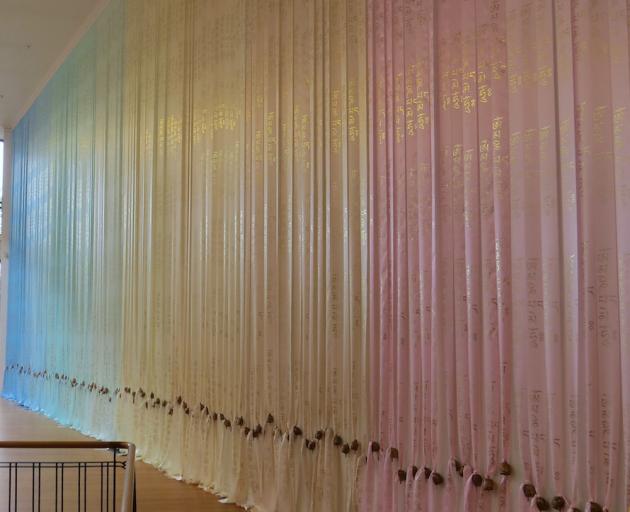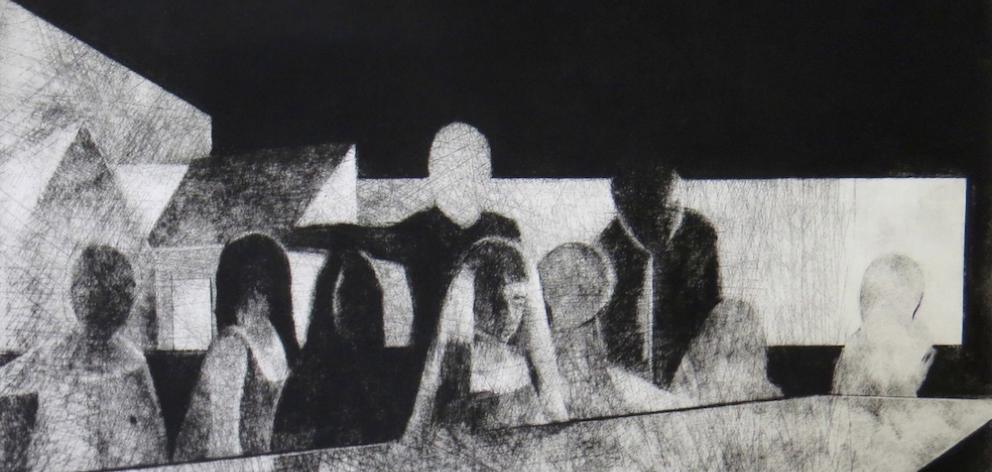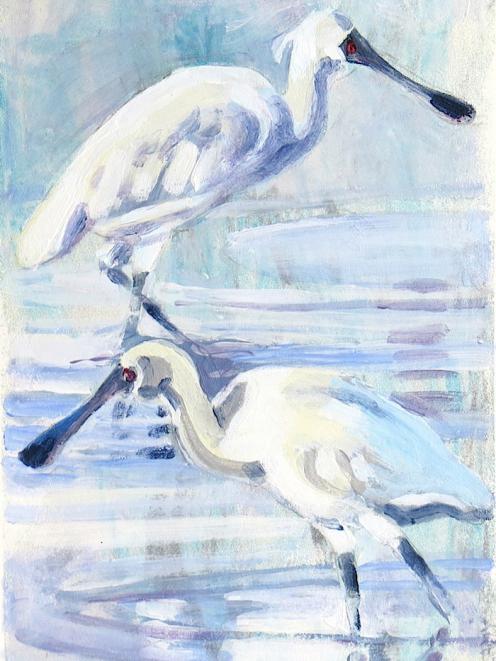In this week's Art Seen, James Dignan looks at exhibitions by Tiffany Singh, John Drawbridge, and Pauline Bellamy.
 Om Mani Padme Hum, by Tiffany Singh.
‘‘Om Mani Padme Hum’’, Tiffany Singh (Dunedin Public Art Gallery)
Om Mani Padme Hum, by Tiffany Singh.
‘‘Om Mani Padme Hum’’, Tiffany Singh (Dunedin Public Art Gallery)

Tiffany Singh's installation at the Dunedin Public Art Gallery draws heavily on Buddhist teachings in its exploration of colour and the path to enlightenment.
Vertically arrayed coloured ribbons form a spectrum that seems to split the light entering the gallery from the Octagon. Light is broken into its component colours, colours invisible when combined as white. As visible colours combine into the invisible, so too Buddhist teaching talks of pure enlightenment reached by a harmonious mix of thought and action, method and wisdom.
This divine union is at the heart of the mantra that lends its name to this exhibit, and a recording of the soothing, hypnotic recited drone accompanies the work.
The ribbons, inscribed in gold with the repeated phrase in Tibetan script, catch the light, producing a rippling effect as the viewer moves around the gallery. Each ribbon is weighed down by a bell, symbolic of the use of such instruments in Buddhist practice worldwide.
The entire effect is calming and pleasing, yet also paradoxical. The ribbons form a static curtain over emptiness, and the bells are mute in response to the call of the mantra. Apparent paradox, though, is often an integral part of the teachings on the road to Buddhist enlightenment.
 The Party, by John Drawbridge.
’’The Edge of Earth’’, John Drawbridge (Fe29 Gallery)
The Party, by John Drawbridge.
’’The Edge of Earth’’, John Drawbridge (Fe29 Gallery)

The late John Drawbridge was undoubtedly one of New Zealand's most versatile printmakers. A retrospective, containing items covering some 40 years of work, is now on display at Fe29 Gallery.
A major strength of Drawbridge's practice is the manner in which he was able to seamlessly blend an astonishingly wide range of influences. Dutch masters, Suprematists, symbolists and Impressionists are all brought magpie-like into individual works.
The disparate elements are synthesised into something unique which defies pigeonholing. In one work there may be a direct homage to Vermeer, yet with a disturbing low-key lighting which more readily suggests Redon; in another, stencil-like Matisse forms combine with precise depictions of glass transparency. Works such as The Party skilfully combine elements of Manet, Goya, da Vinci and de Chirico to produce something haunting and otherworldly.
In all these works there is also the hand of someone who was clearly a master of his medium. Many of the darker, more shadowy images almost give the impression of charcoal drawings rather than mezzotint and drypoint work. The compositions hint at internal narratives yet leave the precise details to the viewer, meaning that the images linger long in the mind.
 Spoonbills, by Pauline Bellamy.
‘‘Sharkie Smartie’’, Pauline Bellamy (Bellamys Gallery)
Spoonbills, by Pauline Bellamy.
‘‘Sharkie Smartie’’, Pauline Bellamy (Bellamys Gallery)

At Bellamys Gallery, an exhibition by Pauline Bellamy revolves around a series of illustrations the artist has done for a children's book, Sharkie Smartie, written by Wilma McKay.
The book tells a tale based on a true incident with a yellow-eyed penguin, rescued by David and Wilma McKay after a shark attack in the waters off Otago Peninsula. As a result, the images show beach and sea scenes populated by the titular penguin, fish, humans, a seal and a vicious shark.
The images are cleverly created using boldly painted detail over a pastel background wash produced by watery inks printed through an open silk screen. The use of screen-print technology in this way produces a soft, defocused land and sea backdrop, over which the animal and human protagonists stand out strongly. The figures thus inhabit scenes that appear natural without being overwhelmed by them. The characters themselves are strongly drawn and full of personality, as befits the actors in a children's book.
The exhibition is rounded off with a handful of other seabird-related images by Bellamy, including several paintings of albatrosses and mollymawks, and some moody and evocative depictions of wading spoonbills.












